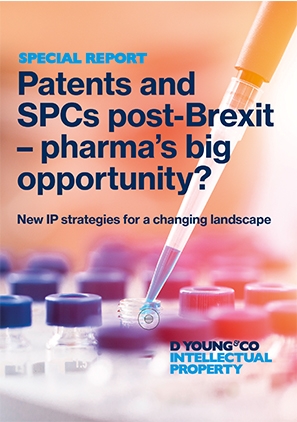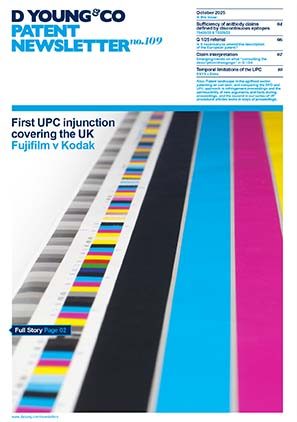Santen (C-673/18): CJEU takes a restrictive view on “first authorisation” for new therapeutic applications
In July 2020, the CJEU handed down its eagerly anticipated decision concerning the question of whether applicants can be granted an SPC based on a “second medical use” patent and a marketing authorisation for a new therapeutic application of a medicinal product previously authorised for a different application. This decision clears up a great deal of uncertainty in the interpretation of Article 3(d) of the EU medicines SPC Regulation (469/2009) that has raged since the CJEU’s earlier decision in Neurim (C-130/11), although perhaps not in the way some in the pharmaceutical industry may have hoped.
SPCs extend the term of patents for medicinal and plant protection products in Europe which have been granted a marketing authorisation (MA). However, Article 3(d) of the SPC Regulation requires that the MA is the “first authorisation to place the product on the market as a medicinal product”.
This decision addresses the issue of whether an MA can be considered to be the “first authorisation” if it is directed to a new therapeutic application of an active ingredient that has previously been authorised for a different therapeutic use.
Brief history leading to uncertainty
As noted above, Article 3(d) requires that the MA relied upon must be the first authorisation to place the product on the market. Article 1(b) of the SPC Regulation defines the “product” as the active ingredient or combination of active ingredients of a medicinal product. Therefore, a literal reading of the Regulation would appear to forbid an SPC for a medicinal product based on a new MA for a product previously authorised for another therapeutic use because the product is defined in the Regulation as referring to the active ingredient itself rather than including in its definition the indication. Early CJEU case law appeared to confirm this, with decisions such as Pharmacia Italia (C-31/03) and Yissum (C-202/05) stipulating that the concept of “product” cannot include the therapeutic use of an active ingredient.
However, in its decision in Neurim (C-130/11), the CJEU, perhaps surprisingly, allowed an SPC based on a second medical use patent and an MA which fell within the scope of that patent, despite the existence of an earlier MA for a veterinary use of the same product. The basis for its decision in Neurim was predominantly concerned with ensuring that the fundamental objective of the SPC Regulation – to provide sufficient protection to encourage pharmaceutical research – was achieved. The CJEU therefore did not focus on the literal wording of the Regulation when reaching the decision in Neurim, but rather took a teleological approach to interpreting the provisions to protect the aims and objectives of the Regulation.
Since Neurim, there has been much uncertainty as to whether the principles must be limited to the facts of Neurim (for example, veterinary v human application), or whether they can be applied more widely to allow SPCs for any new therapeutic applications (or even different formulations, dosages and methods of administration) of previously authorised products.
Summary of decision
In this case, Santen had applied for an SPC in France based on a European patent claiming an ophthalmic emulsion in which the active ingredient is cyclosporine. In its application, Santen referred to the MA it had been granted in 2015 for the product “Ikervis” whose active ingredient is cyclosporine. The MA was granted for the use of Ikervis in treating severe keratitis. At first instance, the French Patent Office rejected the SPC application on the basis that the MA for Ikervis was not the “first authorisation” to have been granted for the product, citing an MA that had been granted back in 1983 for a product called “Sandimmun” for preventing rejection of transplants; the active ingredient in Sandimmun was also cyclosporine.
Santen appealed against this decision to the French Court of Appeal, citing Neurim. The Court of Appeal subsequently referred the matter to the CJEU, asking questions that sought to clarify how far-reaching the decision in Neurim is for the interpretation of Article 3(d).
In contrast to Neurim, the CJEU in Santen started with a consideration of the meaning of the term “product”. In particular, it first considered whether a new therapeutic application of an active ingredient may be considered as being a product distinct from another already known application of the same active ingredient. Based on the definition in Article 1(b), the CJEU held that the notion of “product” does not depend on the way in which the product is used, thus agreeing with the earlier CJEU decisions in Pharmacia and Yissum.
It then considered whether an MA granted for a new therapeutic application of an active ingredient may be regarded as being the first MA within the meaning of Article 3(d) where that MA is the first MA to fall within the scope of protection of the basic patent invoked. The CJEU noted that Article 3(d) does not refer to the scope of protection of the basic patent: if it were to be taken into consideration, this would also call into question the “strict definition of the notion of “product”, within the meaning of Article 1(b)”.
The CJEU therefore departed from the Neurim decision and held that the scope of the basic patent was irrelevant in determining whether Article 3(d) was met. In fact, the CJEU went as far as to entirely dismiss the premise arising from Neurim that it may be possible to obtain an SPC for a new therapeutic application of a previously authorised active ingredient.
Reasons
At the heart of this decision is the strict interpretation given to the meaning of the term “product” in Article 1(b). The CJEU concluded that this narrower interpretation fulfils the objectives of the SPC Regulation by balancing the encouragement of pharmaceutical research with the interests of public health. The CJEU also factored into its decision that a wider interpretation would compromise the simplicity of the SPC system and lead to divergent decisions from national patent offices.
It has long been accepted that a “teleological” interpretation of the SPC Regulation – an interpretation in line with the aims and objectives of the Regulation – is to be applied. In Santen, the CJEU seemingly reconciled a literal interpretation of the Regulation with a teleological interpretation in this particular instance.
Emphasis was placed in the decision on point 11 of the Explanatory Memorandum for the proposed SPC Regulation (1990) to support the CJEU’s view that a wider interpretation would run counter to the Regulation’s objectives. This point 11 indicates that the Regulation should not involve granting a certificate for all medicinal products that are authorised to be placed on the market, and that only one certificate may be granted for any one product with a product being understood to mean an active substance “in the strict sense”.
Of interest is the CJEU’s reference to point 12 of the Memorandum, which states: “the proposal is not confined to new products only. A … new application of the product may also be protected by a certificate. All research, whatever the strategy or final result, must be given sufficient protection”.
Whilst this paragraph could be interpreted in a number of different ways, the CJEU commented that the narrow interpretation of “product” was not called into question by this paragraph. Indeed, it noted that it is still possible to obtain an SPC for a new application of a known product if that product has not been authorised in an earlier MA (i.e. a second medical use patent may still also serve as the basic patent for an SPC).
It is also interesting to note the difference in reasoning between the CJEU in Neurim and Santen regarding the interpretation of the Memorandum:
- In Neurim, the CJEU adopted a wider interpretation based on the statement made in point 29 of the Memorandum that “all pharmaceutical research, provided that it leads to a new invention that can be patented, whether it concerns … a new application of a new or known product …, must be encouraged, without any discrimination”. In its Neurim decision, the CJEU therefore placed more weight on the encouragement of all pharmaceutical research.
- Conversely, the CJEU in its Santen decision took an interpretation that balances more evenly the encouragement of pharmaceutical research and the interests of public health. In this regard, the CJEU opined that the Memorandum makes it clear that the purpose of SPC Regulation is not to promote protection of any pharmaceutical research, but rather to promote that which leads to the first placement of a product on the market.
The CJEU’s decision in Santen was thus unequivocal in ruling out the possibility of obtaining an SPC for a new therapeutic application of a previously authorised product. If it were the intention of the legislator to allow such SPC protection, then this could perhaps still be achieved through a change in the legislation itself.
Implications & take-home message
The CJEU’s decision in Santen has provided some much-needed clarity on the interpretation of Article 3(d). However, it may cause concern amongst some practitioners that the distinction between the term of protection that may be restored by an SPC for an entirely new (unauthorised) product and that for a previously authorised product may disincentivise research into new uses of previously authorised products.
In terms of practical implications, the take-home message should of course be that it will not be possible to have an SPC granted based on an MA that is directed to a new therapeutic application of an active ingredient (or combination of active ingredients) that has already been the subject of an earlier MA directed to a different application.
However, that is not to say that a second medical use patent cannot serve as the “basic patent” for an SPC. An MA granted for a new indication or application within the scope of the second medical use patent may be the “first MA” within Article 3(d) if the product has never before been the subject of an MA. Indeed, many instances can be envisaged where products have been disclosed (perhaps in earlier patent filings), but which have never gone on to be authorised for any other use prior to the authorisation being relied upon within the scope of the later-filed second medical use patent.
The key question to consider when devising any SPC filing strategy must therefore be whether the active ingredient (or combination of active ingredients) has ever before been the subject of an MA for any therapeutic application.


